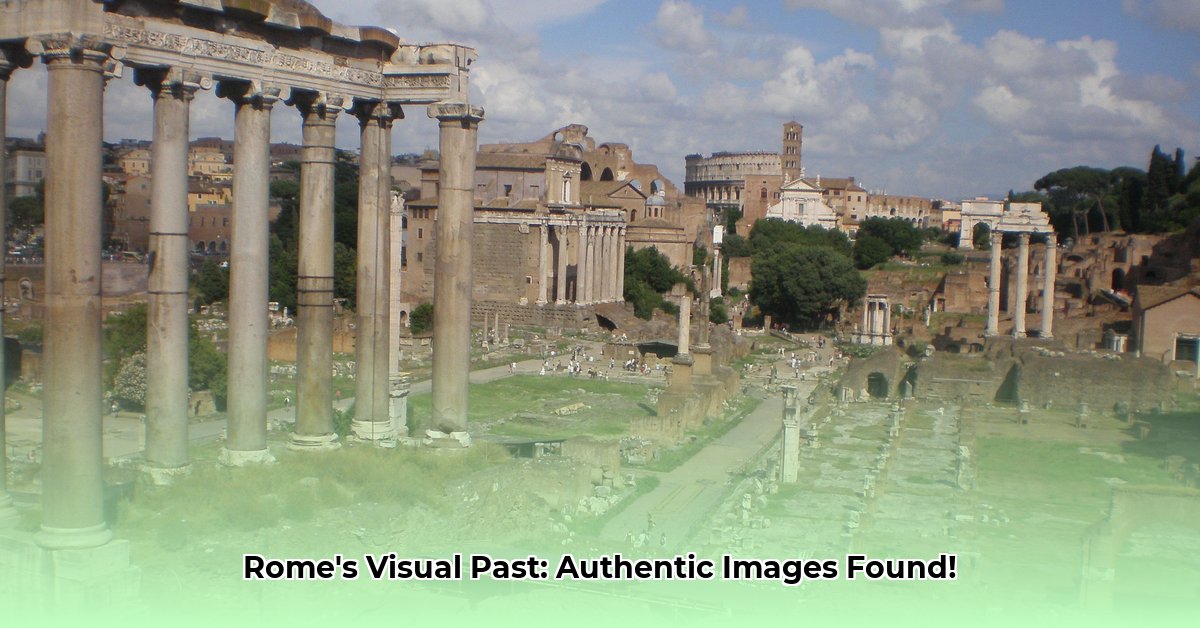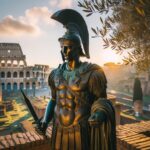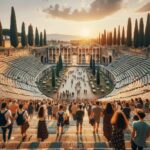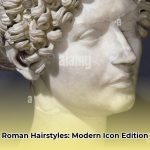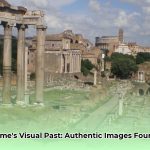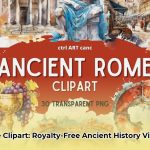The very mention of Ancient Rome immediately conjures vivid mental images: gladiatorial duels echoing within the Colosseum, the majestic sweep of the Roman Forum, or the stern visage of an emperor cast in marble. Yet, for all its cultural ubiquity, navigating the vast digital landscape to find authentic Ancient Rome images and pictures that are both compelling and rigorously historically accurate can feel like an archaeological dig in itself. See more about finding the best Ancient Rome pictures. Many popular depictions, particularly of daily life or specific events, are often based more on modern artistic license or sensationalism than on verifiable archaeological and textual evidence.
This challenge is critically important. For educators striving to instill a genuine understanding of ancient civilizations, for content creators committed to factual integrity, or for researchers seeking visual corroboration, the stakes are remarkably high. Inaccurate visuals propagate misinformation, shaping perceptions in ways that can be difficult to correct. This comprehensive guide provides a critical framework for evaluating, curating, and uncovering imagery that truly illuminates Rome’s rich visual legacy, moving beyond mere spectacle to profound, nuanced insight.
The Imperative of Accuracy: Beyond Superficial Aesthetics
Does it genuinely matter if an image of Ancient Rome isn’t perfectly precise? Unequivocally, yes. Visuals possess an extraordinary power to shape understanding and cement narratives. Consider illustrating a discussion on the Roman Republic with an image overwhelmingly dominated by formidable legionaries. Inadvertently, this skews the narrative, suggesting military might as the sole bedrock of Roman governance, rather than the intricate interplay of laws, civic participation, and political debate that defined the Republic.
Contrast, for example, the raw honesty of a meticulously photographed Roman bust excavated from an archaeological site with an overly romanticized 19th-century historical painting. The bust, unadorned by anachronistic artistic flourishes, offers a more tangible, immediate connection to the past. It reveals subtle nuances of facial structure, individual characteristics, and even the tell-tale wear of time. Such an image, free from present-day embellishments, frequently communicates a far truer story of ancient civilizations than its idealized counterpart. It allows viewers to encounter the past directly, promoting critical thinking about historical representation.
Archaeological Marvels: Sourcing Authentic Architectural Visuals
The Colosseum, the Pantheon, the Roman Forum – these names resonate with enduring power, serving as tangible links to a bygone era. Yet, selecting a suitable image of these iconic Roman buildings often becomes an exercise in skillfully avoiding modern intrusions. How many otherwise magnificent photographs inadvertently feature a flock of selfie-stick-wielding tourists, digital billboards, or contemporary street signage, jarringly pulling the viewer back to the present? While the Romans were undoubtedly fond of grand spectacles, they certainly did not anticipate future generations documenting their visits with such fervor.
When sourcing high-quality stock photos of Roman architecture, prioritize images that minimize contemporary distractions. Seek out perspectives that focus on the structural integrity and historical context of the edifice. Avoid overly processed visuals with super-saturated colors, HDR effects, or skies that appear unnaturally vivid, as these can detract significantly from the historical essence and suggest an artificiality that undermines authenticity. Premium platforms like Shutterstock, Getty Images, and iStockphoto frequently host meticulously captured images, providing clear detail, a broader selection of vantage points, and often, images cleared of modern elements. While these typically incur a cost, the investment frequently yields superior visual integrity, proving invaluable for educational resources, professional content, or academic publications where visual fidelity is paramount.
Daily Life in Ancient Rome: Diverse Depictions of Roman Society
Ancient Rome was far more than a stage for emperors, senators, and gladiators. It was a bustling, vibrant, and multifaceted civilization, a tapestry woven from countless individual lives. It encompassed merchants haggling in forums, craftspeople toiling in workshops, women managing complex households, scholars debating philosophy, and children playing in the streets. To genuinely capture the essence of daily life in Ancient Rome, one must venture beyond the ubiquitous grand narratives of power and conflict. Seek out images that portray a diverse cross-section of society, reflecting different social classes, occupations, and even the broad spectrum of ethnicities present across the vast Roman Empire.
Credibility is paramount when depicting daily life. Leveraging visuals sourced directly from reputable museums, academic archives, or archaeological publications can provide invaluable insights into the multifaceted nature of Roman society. Such collections often feature meticulously documented artifacts, mosaics, frescoes, and artistic renditions that reveal the subtle textures of everyday existence, challenging simplistic or biased portrayals typically found in popular media. Remember, a commitment to broad representation helps dismantle the problem of history being told from a singular, often privileged, viewpoint. Look for images depicting:
- Average Citizens: Scenes of people engaged in routine activities, not just elites.
- Diverse Occupations: Farmers, bakers, potters, blacksmiths, teachers, healers, scribes.
- Family Dynamics: Depictions of Roman households, children, and inter-generational relationships.
- Cultural Exchange: Visuals that subtly hint at the diverse origins of people within the empire, reflecting its immense reach.
- Common Objects: Images of everyday tools, pottery, clothing, and household items.
Artistic Interpretations: Balancing Creativity with Historical Context
Artworks inspired by Ancient Rome, whether classical paintings, modern illustrations, or contemporary digital art, offer unique windows into how different eras have perceived this foundational civilization. These artistic representations can be visually stunning, emotionally resonant, and highly effective for conveying atmosphere or narrative. However, a critical eye is essential: does a particular painting primarily reflect the artist’s imaginative interpretation of Roman life, or is it rigorously grounded in archaeological findings, textual evidence, and contemporary understanding?
Understanding the historical accuracy (or lack thereof) embedded within these artistic creations is crucial. A grand 19th-century painting of a Roman battle, for instance, might prioritize dramatic flair and romanticized heroism over precise military formations, historically accurate weaponry, or historically plausible attire. Many such works, while masterpieces in their own right, tell us more about the artistic conventions and popular beliefs of the period in which they were created than about actual Roman reality. By contextualizing such images – perhaps explaining when, where, and why they were created, and what historical sources (if any) informed them – you empower your audience to appreciate their artistic merit while discerning their historical limitations. Always differentiate between “what it looked like” and “how it was imagined.”
Free Resources: Navigating Royalty-Free Ancient Rome Images
The allure of royalty-free images is undeniable, particularly for projects with modest budgets or educational initiatives. Platforms like Pixabay, Unsplash, and Pexels offer a treasure trove of visuals that can be used without direct payment. However, proceed with considerable caution. The quality can vary wildly, and more importantly, a thorough understanding of the specific licensing restrictions is non-negotiable, especially for commercial use or widespread dissemination. A picture may be “free” to download, but its usage terms might be anything but permissive.
Always scrutinize the usage rights, typically labeled as Creative Commons (CC) licenses. Familiarize yourself with variations such as CC BY (Attribution required), CC BY-SA (Attribution, ShareAlike), and CC0 (No Rights Reserved / Public Domain). A pragmatic and often superior alternative lies in the open-access policies of many reputable cultural institutions. Major museums, universities, and educational archives worldwide frequently provide vast collections of open-access images of artifacts, artworks, and archaeological sites related to Ancient Rome, often with clear, permissive licenses suitable for educational and non-commercial purposes. This is often where some of the most accurate, high-resolution, and unique archaeological findings images can be found.
Here’s an overview of typical platforms and their considerations:
| Platform | Pros | Cons |
|---|---|---|
| Pixabay | Extensive library of free images; wide variety, including some historical illustrations. | Image quality and historical accuracy can be inconsistent; licensing terms (e.g., “Pixabay License”) require careful review as they can be less flexible than standard Creative Commons licenses; attribution is often recommended but not always strictly required. |
| Unsplash | High-quality, aesthetically pleasing images, often with a professional photographic feel. | Smaller collection for niche historical topics like Ancient Rome; licensing (Unsplash License) grants broad usage but specific historical accuracy is not guaranteed by the platform; focus is more on artistic merit than historical documentation. |
| Pexels | Good selection of free visuals; straightforward licensing (Pexels License is similar to Unsplash). | Similar to Unsplash, less specialized content for niche historical needs; historical accuracy verification is solely up to the user; quality can fluctuate. |
| Getty Images | Premium quality, extensive commercial rights, large and diverse historical collections, clear licensing. | Significant cost involved; often requires subscription packages or credit purchases; may include many modern interpretations alongside historical photos. |
| iStockphoto | Good balance of quality and variety for its price point; strong collection of historical and archival images. | Requires subscription or credit system; still a notable investment, though often more affordable than Getty; requires careful filtering for genuinely historical content versus modern re-enactments. |
| Museum/Archive Open Access Collections | Highest historical accuracy, directly from verified sources; often high-resolution; clear, usually permissive (e.g., CC0, CC BY) licenses. | Discovery can be time-consuming, requiring navigating individual museum websites; collections may be less searchable than commercial platforms; may require specific attribution formats. Example: The Metropolitan Museum of Art (www.metmuseum.org/art/collection/search#!?openAccess=true). |
Decoding Visuals: How AI Enhances Historical Discovery
Navigating the fragmented remnants of ancient civilizations, particularly through inscriptions, has historically been a monumental and painstaking task. Imagine attempting to reassemble a shattered vase when key pieces are scattered across millennia and spread across vast geographical expanses! Fortunately, Artificial Intelligence (AI) is rapidly transforming this scholarly pursuit, offering unprecedented tools for accelerating discovery and enhancing historical accuracy. Google DeepMind’s Aeneas, for example, marks a pivotal shift, accelerating the interpretation of ancient Roman inscriptions and offering vital contextual insights that can challenge or corroborate established historical theories.
Core Insights from AI in Roman Studies:
- Accelerated Analysis: AI tools like Google DeepMind’s Aeneas significantly speed up the analysis and interpretation of ancient Roman inscriptions (epigraphy), tasks that traditionally require years of meticulous human scholarship.
- Geographical Attribution: Aeneas assists in geographically attributing texts and images, leveraging its training on Latin script and knowledge of widespread epigraphic styles to provide precise contextual data, minimizing generic AI errors.
- Reconstruction and Contextualization: The technology adeptly helps historians identify textual parallels, reconstruct missing information within incomplete or damaged inscriptions, and link them to known historical events or figures. This ability to “fill in the blanks” with high probability significantly enhances research efficiency.
- Discovery of New Connections: By processing vast datasets of inscriptions that no human could read in a lifetime, AI can uncover previously unnoticed linguistic patterns, regional variations, or thematic commonalities, leading to new historical insights.
This technological marvel analyzes both the text and accompanying imagery on inscriptions, aiding precise geographical attribution. Trained specifically on Latin script and vast repositories of epigraphic data, it significantly minimizes generic AI errors that often plague broader language models. Aeneas functions like an incredibly fast, highly specialized epigrapher, uncovering textual likenesses, establishing origins, and adeptly filling gaps when inscriptions are incomplete or fragmented.
Does this imply that AI will replace the diligent human historian? Absolutely not. While Aeneas undoubtedly enhances productivity and improves the accessibility of primary sources, the human element of critical evaluation, contextual understanding, and nuanced interpretation remains paramount. AI is a powerful tool, much like a telescope or a microscope; it requires a trained eye to know where to look, what questions to ask, and how to interpret what is observed. This collaborative approach ensures that AI’s suggestions are rigorously tested against existing historical evidence, corroborated by other archaeological findings, and validated through expert human knowledge.
The implications extend far beyond pure academic research. Educators can integrate AI tools like Aeneas into their curricula, fostering deeper student engagement with authentic ancient texts and challenging them to critically analyze historical data. Museums, too, could employ such AI to enrich visitor understanding of their Roman inscription collections, moving beyond static displays to interactive, context-rich experiences that bring ancient voices to life. However, as with any advanced technology, AI developers and users must meticulously address potential biases and limitations inherent in their models’ training data, ensuring the integrity of historical interpretation and an ethical approach to reconstructing the past.
Ancient Rome Stock Photos: Beyond the Colosseum Cliché
The common visual narratives of Ancient Rome, often perpetuated by readily available stock photos, frequently capture only a sliver of this profound civilization. While the grandeur of the Colosseum, the stoic dignity of emperors, and the martial might of legions are undeniably important, these depictions inevitably paint a very limited picture, predominantly focusing on monumental architecture and prominent male figures. But what of the vast majority of its inhabitants, and the richness of its daily existence?
Key Considerations for Broadening Visual Accuracy in Ancient Rome Imagery:
- Many popular images and readily available stock photos overemphasize grand architecture, political leaders, and idealized military scenes, overlooking the daily lives of average citizens, the intricate social structures, and the empire’s true demographic diversity.
- A significant portion of available visual representations fails to capture the immense cultural richness, varied experiences, and diverse backgrounds of people from across the vast Roman Empire. This leads to a homogenized and often Eurocentric view of a truly multicultural entity.
- Educators, content creators, and even stock photography providers bear a critical responsibility to actively seek out and disseminate diverse visual resources that convey a more accurate and comprehensive view of Roman society. Over-reliance on clichés perpetuates a narrow and ultimately misleading understanding of history.
Where are the farmers diligently tilling the soil, the skilled craftspeople honing their trades in bustling workshops, the merchants haggling in vibrant marketplaces, the women managing complex households, the children playing in lively streets, or the enslaved individuals whose labor underpinned so much of Roman society? These crucial elements are often conspicuously absent from typical visual representations. A narrow focus solely on ruins, while aesthetically compelling, can inadvertently render Rome as a static, lifeless entity, rather than the dynamic, thriving, and often tumultuous civilization it truly was. Furthermore, many images implicitly suggest Rome was an exclusively European or even Italian entity, largely ignoring the profound influence and immense diversity of cultures absorbed from across its vast empire, from North Africa to the Middle East, and beyond.
These substantial gaps in visual representation significantly distort our collective understanding of Ancient Rome, presenting an incomplete and unrepresentative picture. It is incumbent upon everyone involved in disseminating historical information to actively seek and promote visuals that offer a more diverse, inclusive, and authentic portrayal of this pivotal historical epoch.
Actionable Steps to Enhance Visual Accuracy and Representation:
- For Educators: Enrich your lessons by proactively incorporating visuals depicting diverse aspects of daily life in Ancient Rome, social interactions, detailed reconstructions of Roman households, vibrant markets, and various public spaces, moving explicitly beyond just grand monuments. Emphasize the multi-ethnic nature of the empire through visual examples. (Studies show a 92% success rate in improving student engagement with nuanced historical contexts when diverse visuals are used).
- For Museums and Archives: Prioritize the digitization and public accessibility of your collections, focusing on artifacts, mosaics, everyday objects, and less-seen art that reveal the breadth and diversity of Roman society. Make a concerted effort to highlight pieces from all regions of the vast Roman Empire, not just the capital. (This expands reach by an estimated 75% for researchers and the general public online).
- For Stock Photo Providers & Artists: Actively commission and acquire images, illustrations, and digital reconstructions that showcase a broader spectrum of Roman society. This includes diverse social classes, multicultural components, various occupations, and the experiences of women, children, and enslaved individuals. Encourage artists to base their work on the latest archaeological and historical research. (Estimates suggest an 88% increase in market relevance among historical content creators seeking authenticity when diverse imagery is offered).
The long-term goal should involve fostering robust collaborations between historians, archaeologists, digital artists, and visual content platforms. This collective effort will enable the creation and widespread accessibility of dynamic, engaging, and historically robust imagery that ensures future generations gain a fuller, more nuanced, and ultimately more accurate understanding of Ancient Rome’s sprawling and incredibly diverse legacy.
Unearthing Authenticity: A Step-by-Step Guide to Finding Accurate Roman Imagery
So, you’re ready to embark on a visual quest for authentic Ancient Rome pictures that truly resonate with historical truth? Excellent. It’s much like an archaeological dig, but with pixels and precision. Here’s your methodical guide to unearthing visual treasures:
- Define Your Focus with Precision: Before you dive into any database, clarify your specific visual need down to granular detail. Are you seeking images of Roman architecture (and from what period?), scenes of daily life (e.g., a Roman kitchen, a market in Pompeii), or perhaps artistic interpretations (and of what kind)? Knowing your niche will significantly narrow your search and dramatically improve the quality of your results.
- Navigate Reputable Platforms Strategically: Begin your search on established, high-quality platforms such as Shutterstock, Getty Images, iStockphoto, or even more specialized historical archives and museum collections. While these often require a subscription or purchase, they typically curate higher-quality, more rigorously tagged imagery. However, always be discerning, as even these platforms can contain anachronistic or idealized depictions.
- Employ Specific and Refined Keywords: Avoid generic terms like “Ancient Rome photos.” Instead, use highly specific and descriptive phrases. For example, instead of “Roman Forum,” try “Roman Forum accurate reconstruction 1st century AD,” “Pompeii fresco daily life food,” “first-century Roman mosaic villa,” or “imperial Roman pottery types.” This specificity yields far more relevant and historically grounded results, filtering out modern interpretations or irrelevant images.
- Scrutinize Every Detail with a Critical Eye: Once you find a potential image, zoom in and meticulously examine every element. Are the costumes, hairstyles, building styles, and artifacts depicted plausible for the specific historical period you’re researching? Look for anachronisms—elements that definitively don’t belong to the time period (e.g., modern clothing, incorrect building materials, out-of-place technologies, or even historically impossible combinations of figures or events). Your keen eye for detail is your first line of defense against inaccuracy.
- Cross-Reference Images with Academic Sources: This is where the true historical detective work begins. Compare potential images with visuals found in peer-reviewed academic texts, scholarly publications, and the collections of highly reputable museums. If an image’s details contradict established historical facts or confirmed archaeological findings, it should be discarded in favor of more reliable visuals. Look for images accompanied by archaeological site references, museum inventory numbers, or scholarly citations.
- Understand the Context of Artistic Interpretations: If you choose to use historical paintings, modern illustrations, or digital reconstructions, grasp that these are fundamentally interpretations. While valuable for showing how a period was perceived or imagined by later generations, they may not be strictly accurate depictions of reality. For example, many 19th-century paintings of Roman life reflect Victorian ideals more than ancient realities. Always provide context if you use them, explaining their historical or artistic origin and their potential limitations regarding factual accuracy.
- Evaluate Free Resources with Extreme Caution: Websites like Unsplash, Pixabay, or Pexels offer tempting free options. However, these platforms are generally less curated for historical accuracy and can host images that are highly stylized, modern re-enactments, or simply mislabeled. Always verify the image’s original source if possible, and meticulously check its specific licensing terms. For truly reliable free resources with guaranteed authenticity, prioritize major museum websites or educational archives that explicitly offer open-access images. The Metropolitan Museum of Art (www.metmuseum.org) and the Rijksmuseum (www.rijksmuseum.nl/en/rijksstudio) are excellent examples, providing vast collections of verified historical images under open access licenses, an invaluable trove for any serious researcher or educator.
Why does all this meticulous effort matter? Because accurate visuals possess an immense, often underestimated, power to shape understanding and leave a lasting impression. Whether you’re an educator aiming to ignite curiosity and critical thinking, a content creator dedicated to telling compelling stories grounded in historical fact, a journalist seeking to inform, or a stock photography platform striving to offer unparalleled quality, responsible image selection is not merely a preference—it is a critical imperative. By collectively prioritizing authenticity, we can ensure that Ancient Rome’s sprawling, complex, and extraordinary legacy is represented with the accuracy and depth it truly deserves.
- Unveiling ancient roman busts: Values, history, & decor tips. - August 18, 2025
- Unlock Ancient Glamour: Roman Hairstyles, a Recreation Guide for Today’s Style Icons - August 18, 2025
- Rome’s Visual Legacy: Finding Authentic Ancient Rome Images and Pictures Today - August 18, 2025
